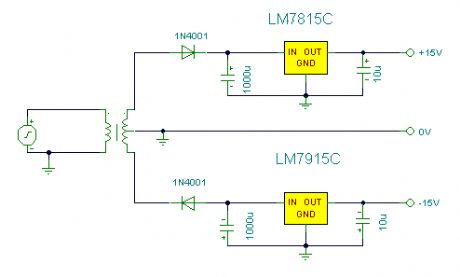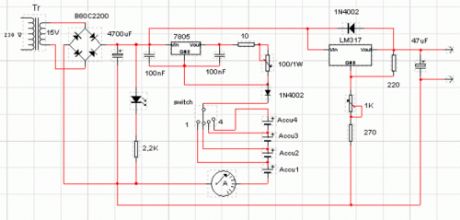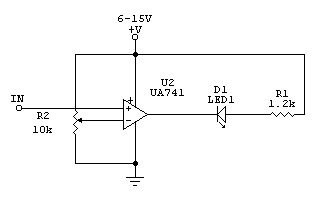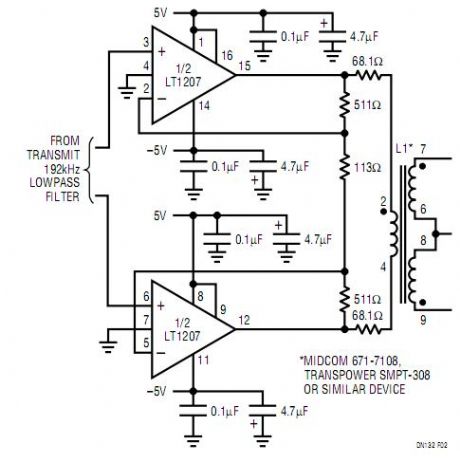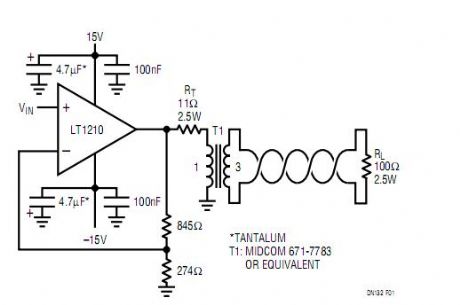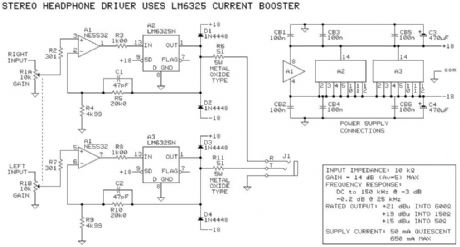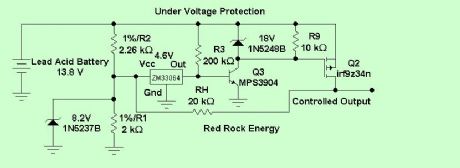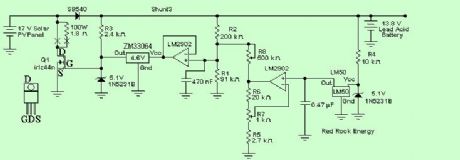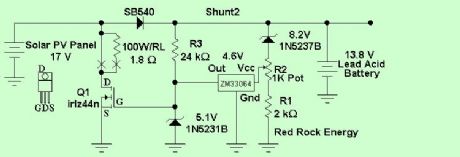
Index 10
Brightness Control for small Lamp
Published:2013/7/23 21:12:00 Author:muriel | Keyword: Brightness Control, small Lamp
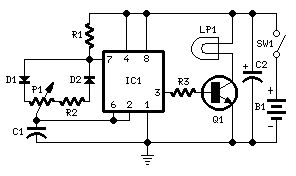
Parts:P1 470K Linear PotentiometerR1 10K 1/4W ResistorR2 47K 1/4W Resistor (See Notes)R3 1K5 1/4W ResistorC1 22nF 63V Polyester CapacitorC2 100µF 25V Electrolytic CapacitorD1,D2 1N4148 75V 150mA DiodesIC1 7555 or TS555CN CMos Timer ICQ1 BD681 100V 4A NPN Darlington TransistorLP1 1.5V 200mA Bulb (See Notes)SW1 SPST SwitchB1 3V (Two 1.5V AA or AAA cells in series, etc.)
Circuit operation:This device was designed on request, to control the light intensity of four filament lamps (i.e. a ring illuminator) for close-up pictures with a digital camera, powered by two AA or AAA batteries. Obviously it can be used in other ways, at anyone's will.IC1 generates a 150Hz squarewave having a variable duty-cycle. When the cursor of P1 is fully rotated towards D1, the output positive pulses appearing at pin 3 of IC1 are very narrow. Lamp LP1, driven by Q1, is off as the voltage across its leads is too low. When the cursor of P1 is rotated towards R2, the output pulses increase in width, reaching their maximum amplitude when the potentiometer is rotated fully clockwise. In this way the lamp reaches its full brightness.
Notes:LP1 could be one or more 1.5V bulbs wired in parallel. Maximum total output current allowed is about 1A.R2 limits the output voltage, measured across LP1 leads, to 1.5V. Its actual value is dependent on the total current drawn by the bulb(s) and should be set at full load in order to obtain about 1.5V across the bulb(s) leads when P1 is rotated fully clockwise.
(View)
View full Circuit Diagram | Comments | Reading(943)
Instrument panel lamp dimmer control
Published:2013/7/23 21:07:00 Author:muriel | Keyword: Instrument panel, lamp dimmer , control
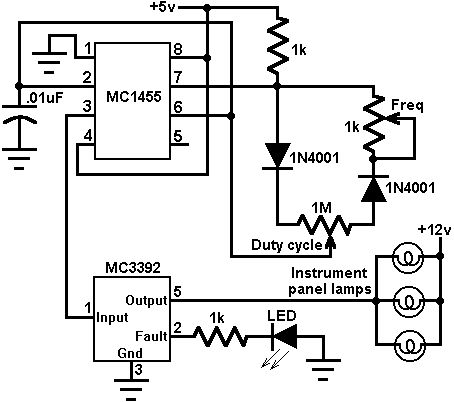
This circuit uses an MC3392 low side protected switch and an MC1455 timing circuit to form an automotive instrumentation panel lamp dimmer control. The brightness of incandescent lamps can be varied by Pulse Width Modulating the input of the MC3392. The modulating signal can be obtained directly from the MC1455 timer (or a microprocessor). The MC1455 is configured as a free-running clock having a frequency and duty cycle control. The typical timer frequency is approximately 80 Hz when the frequency potentiometer is adjusted to 1.0k. This frequency was chosen so as to avoid any perceptible lamp flicker. The duty cycle potentiometer controls the duty cycle over a range of about 3% to 97%. When at 3% the lamps are essentialy off, at 97% the lamps are essentially full on. Any number of lamps can be control, so long as the total load current is less than 1 amp. The LED is used to signal the existence of a system fault (overvoltage, current limiting, or thermal shutdown). (View)
View full Circuit Diagram | Comments | Reading(1021)
Fuse Monitor / Alarm
Published:2013/7/18 20:51:00 Author:muriel | Keyword: Fuse Monitor , Alarm
View full Circuit Diagram | Comments | Reading(859)
Solid State Power Controller
Published:2013/7/18 20:34:00 Author:muriel | Keyword: Solid State, Power Controller
View full Circuit Diagram | Comments | Reading(1119)
Low Voltage Alarm circuit
Published:2013/7/18 20:32:00 Author:muriel | Keyword: Low Voltage, Alarm circuit
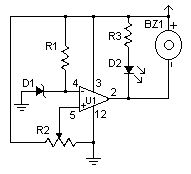
This low voltage circuit can be used to monitor batteries and other volatile sources of current for problems. The circuit sounds an alarm and lights an LED, but can be interfaced to any number of other circuits for many different uses. (View)
View full Circuit Diagram | Comments | Reading(1187)
Voltage Monitor
Published:2013/7/18 20:31:00 Author:muriel | Keyword: Voltage Monitor
View full Circuit Diagram | Comments | Reading(0)
Receiver Battery Low Voltage Alarm
Published:2013/7/18 20:31:00 Author:muriel | Keyword: Receiver, Battery, Low Voltage, Alarm
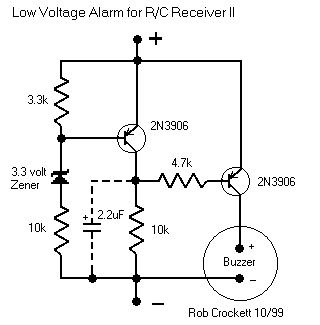
Here is another equally cool low voltage alarm circuit for your glider receiver battery that I've shamelessly stolen from George Steiner's book A to Z--Radio Control Electronic Journal (see below). I've modified it to use with small battery packs in R/C gliders. This design has a trigger voltage at about 4.3 volts, and it draws 1mA or less when quiet and about 4mA when buzzing. This can be constructed from parts fromt Radio Shack, though you may need to order a few through them.The voltage of a receiver system is punctuated by low-voltage spikes every time the servo motors spin up, since the servos draw more than the battery can deliver. With large receiver battery packs, this is not as much of an issue, and it may not be noticeable. However with 270mA and smaller battery packs, particularly with more than two servos, low voltage alarms can chirp constantly, every time a servo moves. The challenge is to design in a little slack or delay, just enough so that you are not annoyed by constant chirping, but not too much so that the chirps can give you a warning before the battery is completely exhausted. Here, this hysteresis is adjusted with the capacitor. For large packs (600mA and above), no capacitor is probably needed, although I've been using a 1uF capacitor on my open class ship with 6 servos and a 600mA battery. For 270 mA and two servos, I'd suggest trying a 1uF capacitor. For 150mA or less, a 2.2uF capacitor works well. If you want to know only when the battery has finally reached the trigger voltage, try a 5uF (or 4.7uF) capacitor. The actual type of capacitor is not critical, but tantalum capacitors are physically smaller. If you want to worry about the polarity of the capacitor, the negative side should be directed toward the negative pole of the battery, but at these relatively low voltages compared to the capacitor rating, the polarity probably does not matter.This circuit is set up for a four cell receiver battery pack at a trigger voltage of about 4.3 volts (about 1.1volts/cell). You can adjust R1 (here a 3.3k resistor) to change the trigger voltage of the circuit. For example, for a 5 cell pack, to change the trigger voltage to 5.5 volts, change R1 to 2.2k. For a three cell pack, to change the trigger voltage to 3.3 volts, change R1 to 6.8 k (or use two 3.3k resistors in parallel by soldering a resistor in each hole and twisting together the top leads). Because of slight variability in tolerances of the componants, you should check this little device with a variable power source and a voltmeter to confirm its trigger point. Alternately, use your digital voltmeter or expanded scale voltmeter to calibrate its chirp pattern by measuring the voltage of the onboard battery pack intermittently as you fly.Make sure the band on the Zener diode is toward the + side (toward R1). Solder a battery connector or servo connector to the board with positive and negative as shown, and plug the connector into an unused slot in your receiver. (View)
View full Circuit Diagram | Comments | Reading(1509)
Precision Receiver Battery Low Voltage Alarm
Published:2013/7/17 21:59:00 Author:muriel | Keyword: Precision , Receiver, Battery, Low Voltage, Alarm
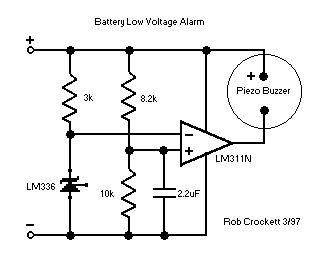
Flying hand launch gliders means living with small capacity receiver NiCad battery packs. These small packs are light, but have the distinct disadvantage of rapidly depleting. You can carefully time your flights, but you end up either crashing when your plane seizes or using only a portion of the already small capacity of the battery. If you charge the battery in a slightly suboptimal fashion, your plane dies and bites the dirt (done that, crashed). This devices will allow you to use a small mA pack and use the full capacity of your battery.This device of my design uses seven componants on a single side PC board. With a 6 inch connector, the whole thing weighs about 0.2 oz. The alarm sounds with a voltage at or below 4.5v, and the circuit draws 2.4-2.7 mA when quiet and 5.6mA with the alarm (in my Hitec system, a receiver and two servos draw an average 75-100mA when flying). The LM336 and 3k resistor provide a precision reference 2.5 volts, and the two other resistors are a voltage divider that provide the sample voltage. The LM311 is a voltage comparator, and powers the buzzer when the sample voltage crosses the reference. Since servos draw current abruptly and intermittantly, the ambient battery voltage is puncuated by a series of low voltage spikes. The capacitor (not in the original design in the picture) smooths these spikes somewhat so that the alarm does not chirp with every servo motion. These inverted voltage spikes are not so pronounced with larger capacity batteries; the capacitor may not always be be needed. While it is possible to smooth the voltage completely, this chirping provides a continuous and early indication of battery voltage. With the circuit here, the alarm chirps while slewing both servos of a reciever/two servo system when a 150mA battery is about half discharged, chirps with any servo motion when near completely discharged, and alarms continuously with about 5 minutes of flying time left. With a larger capacity battery, the sequence occurrs much nearer to complete discharge--perhaps no capacitor or a smaller one (say 1uf or 0.1uf) would do--and initial comparison with your measured voltages would be important to calibrate to your system. You can adjust the divider resistors for a higher or lower voltage alarm: Vout=Vin(R2/(R1+R2)) where Vout=2.5v and Vin is your selected alarm voltage, and R1 is the positive side and R2 is the negative side. Note that the LM336 has three pins and you only use two (break off the third). Solder a battery or servo connector to the board with positive and negative as shown, and plug the connector into an unused slot in your receiver. (View)
View full Circuit Diagram | Comments | Reading(1794)
Flyback Transformer Driver
Published:2013/7/17 21:54:00 Author:muriel | Keyword: Flyback Transformer Driver
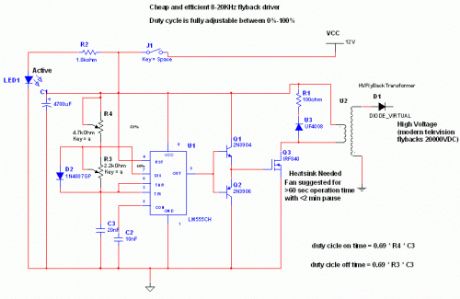
This is an efficient flyback driver for modern cylindrical rectified television flybacks. Many sites doesn't provide circuits driving these transformers, they simply say that they are bad.I don't agree. In fact I built this circuit. I spent a lot of time for finding resonant frequency (around 15Khz) and duty cycle. These transformers best work at around 90% duty cycle. You may notice corona breakdown at terminals and pfffff sound (as well as the ozone smell) when adjusting the off time trimmer to near 500-300 ohms. Of course it will work for other tipes of flyback as frequency and duty cycle have a large range.Frequency range can be increased using multiposition switch for other values of C3 capacitor ,for example 2 nF for 80KHz-200000KHz, but didn't found flybacks with so high resonant frequencies, in addition with higher values of c3 , eg 200nF, 2uF thefrequency will drop making possible the use of ignition coils, and rectified power transformers @50Hz to charge high voltage electrolitic caps at 300-400V). Unfortunately my ignition coil died because insulation breakdown (too long drawn arcs)...I was able to power a small (20cm) Spark Gap tesla coil Using these dc rectified flybacks to charge primary tank capacitor.
The operation is simpleThe 555 is wired as an astable and the capacitor is charged only through the 4,7Kohm trimmer (notice the diode) and discharged only through the 2.2 Kohm trimmer, making the duty cycle full adjustable. The square wave is then feed in a totem pole made up of a 2N3904 and a 2N3906, which are cheap, and easy to find. The totem pole ensures the gate being charged and discharged very fast (approx 50nS i think). The IRF840 is a cheap (i found it for 4euros) reliable and powerful power mosfet, it has current capability of 8 A continuous and 32A pulse, 800V drain source voltage, protecting internal zener diode. There is a snubbing network to ensure that voltage spikes are kept low (unless the insulation of the transformer start to leak) protecting both transistors and 555 IC. 100 ohm is a compromise between decay time and voltage spike.
Comments and specifications:The 100 ohm snubber must me a 5W resistor, or it will burn at long operationsThe led is only for safety purposesUse a dead man switch (pushbutton) for safetyThe power supply must supply at least 2-3 A if you want decent arcs (20000 KV)
Dangers:The flyback driven in this way can supply a significant current, aldough the heart fibrillation starts at 30mAI recommend caution to avoid painful arc-burns.The arc is a hot plasma, never operate the circuit in presence of flammable substances.Charging high voltage capacitors is a serious life threat, so if you arent unexperienced just draw arcs and no moreThis device when rectified generates static voltage that can be a little annoying.... (or fun, i sprayed with corona a plastic pen from positive terminal and then i was able to attract little pieces of paper)
Disclaimer:I don't assume any responsibility of the damages or discruptions dove by this device, to persons or things. Any irresponsable action would be a serios danger. This is high voltage threat it with respect. (View)
View full Circuit Diagram | Comments | Reading(1373)
12VDC Fluorescent Lamp Drivers
Published:2013/7/15 20:26:00 Author:muriel | Keyword: 12VDC , Fluorescent Lamp Drivers
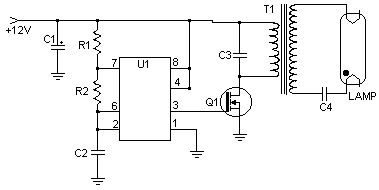
A number of people have been unable to find the transformer needed for the Black Light project, so I looked around to see if I could find a fluorescent lamp driver that does not require any special components. I finally found one in Electronics Now. Here it is. It uses a normal 120 to 6V stepdown transformer in reverse to step 12V to about 350V to drive a lamp without the need to warm the filaments.
Parts:C1 100uf 25V Electrolytic CapacitorC2,C3 0.01uf 25V Ceramic Disc CapacitorC4 0.01uf 1KV Ceramic Disc CapacitorR1 1K 1/4W ResistorR2 2.7K 1/4W ResistorQ1 IRF510 MOSFETU1 TLC555 Timer ICT1 6V 300mA TransformerLAMP 4W Fluorescent LampMISC Board, Wire, Heatsink For Q1
Notes:1. Q1 must be installed on a heat sink.2. A 240V to 10V transformer will work better then the one in the parts list. The problem is that they are hard to find.3. This circuit can give a nasty (but not too dangerous) shock. Be careful around the output leads.
(View)
View full Circuit Diagram | Comments | Reading(805)
Simple Digital Volume Control
Published:2013/7/15 20:01:00 Author:muriel | Keyword: Simple, Digital , Volume Control
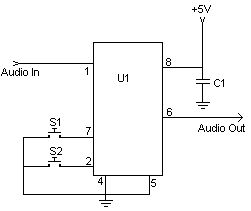
This digital volume control has no pot to wear out and introduces almost no noise in the circuit. Instead, the volume is controlled by pressing UP and DOWN buttons. This simple circuit would be a great touch to any home audio project.
Parts:C1 0.1uf Ceramic Disc CapacitorU1 DS1669 Digital Pot IC (See Notes)S1, S2 Momentary Push Button SwitchMISC Board, Wire, Socket For U1
Notes:1. U1 is available from Dallas Semiconductor.2. S1 turns the volume up, S2 turns it down.3. The input signal should not fall below -0.2 volts.4. Using a dual polariity power supply (+-5V works fine) will cure most clipping problems. You will have to check the data sheet for the correct pins to connect your voltages.
(View)
View full Circuit Diagram | Comments | Reading(937)
Bass-treble tone control circuit
Published:2013/7/15 20:00:00 Author:muriel | Keyword: Bass-treble tone, control circuit
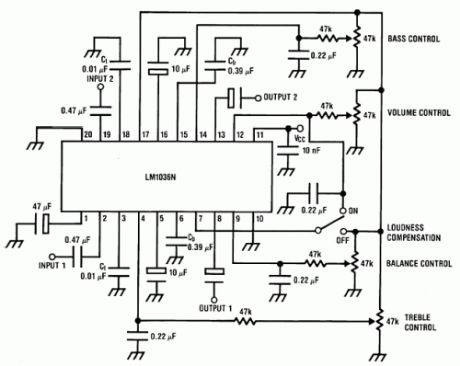
The LM1036 is a DC controlled tone (bass/treble), volume and balance circuit for stereo applications in car radio, TV and audio systems. An additional control input allows loudness compensation to be simply effected. Four control inputs provide control of the bass, treble, balance and volume functions through application of DC voltages from a remote control system or, alternatively, from four potentiometers which may be biased from a zener regulated supply provided on the circuit. Each tone response is defined by a single capacitor chosen to give the desired characteristic.
Features:Wide supply voltage range, 9V to 16VLarge volume control range, 75 dB typicalTone control, ±15 dB typicalChannel separation, 75 dB typicalLow distortion, 0.06% typical for an input level of 0.3 VrmsHigh signal to noise, 80 dB typical for an input level of 0.3 VrmsFew external components required
Note: Vcc can be anything between 9V to 16V and the output capacitors are10uF/25V electrolytic.
(View)
View full Circuit Diagram | Comments | Reading(1375)
CCD Clock Driver
Published:2013/7/11 2:50:00 Author:muriel | Keyword: CCD Clock Driver
View full Circuit Diagram | Comments | Reading(1394)
Bridge Driver for HDSL
Published:2013/7/11 2:50:00 Author:muriel | Keyword: Bridge Driver, HDSL
View full Circuit Diagram | Comments | Reading(848)
Twisted Pair Driver ADSL
Published:2013/7/11 2:49:00 Author:muriel | Keyword: Twisted Pair Driver ADSL
View full Circuit Diagram | Comments | Reading(1010)
stereo headphone driver
Published:2013/7/11 2:34:00 Author:muriel | Keyword: stereo headphone driver
View full Circuit Diagram | Comments | Reading(1098)
Diversion Charge Controller
Published:2013/7/5 1:54:00 Author:muriel | Keyword: Diversion Charge Controller
View full Circuit Diagram | Comments | Reading(1140)
Under Voltage Protection Circuit
Published:2013/7/5 1:54:00 Author:muriel | Keyword: Under Voltage Protection Circuit
View full Circuit Diagram | Comments | Reading(1116)
Temperature Compensated Shunt Charge Controller
Published:2013/7/5 1:53:00 Author:muriel | Keyword: Temperature Compensated, Shunt Charge Controller
View full Circuit Diagram | Comments | Reading(978)
Shunt Charge Controller
Published:2013/7/5 1:52:00 Author:muriel | Keyword: Shunt Charge Controller
View full Circuit Diagram | Comments | Reading(1328)
| Pages:10/312 1234567891011121314151617181920Under 20 |
Circuit Categories
power supply circuit
Amplifier Circuit
Basic Circuit
LED and Light Circuit
Sensor Circuit
Signal Processing
Electrical Equipment Circuit
Control Circuit
Remote Control Circuit
A/D-D/A Converter Circuit
Audio Circuit
Measuring and Test Circuit
Communication Circuit
Computer-Related Circuit
555 Circuit
Automotive Circuit
Repairing Circuit
